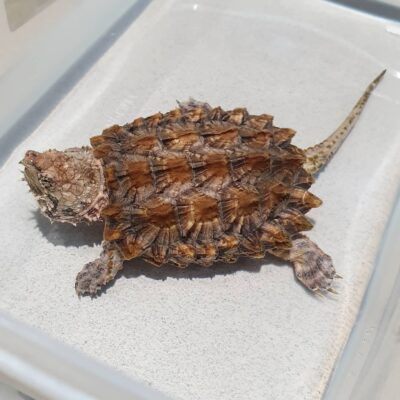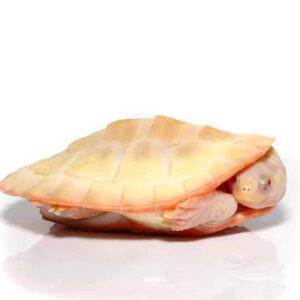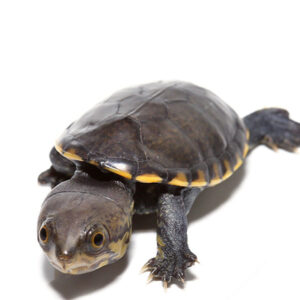Alligator Snapping Turtle For Sale
$200.00
Alligator Snapping Turtle
Alligator Snapping Turtle (Macrochelys temminckii) is a huge species of turtle belonging to the family of Chelydridae. The species is found in the freshwater ecosystems throughout the United States. M. Tamminckii is among the largest freshwater turtles found in the world. It is the biggest freshwater turtle species in North America. It is usually connected to, but is not closely related to snapping turtles and is found in the Genus Chelydra
Alligator Snapping Turtle is distinguished by a massive head that is heavy and a thick, long shell that has three dorsal ridges with massive scaling (osteoderms) that give it a primitive appearance, reminiscent of many of the plate-covered dinosaurs particularly Ankylosaurus.
It is immediately differentiated from the snapping turtles of the common species by three different rows of raised plates and spikes on its carapace as opposed to the standard snapping turtle is smoother in its carapace. M. temminckii can be described as a solid grey or black or olive-green color and is usually covered with algae.
It is characterized by radiating yellow patterns around the eyes. They serve to break up the shape that surrounds the eyelids to help keep the turtle hidden. Also, the eyes can be enclosed by a star-shaped arrangement filamentous, fleshy “eyelashes”.
Diet
Alligator Snapping Turtle, also known as the alligator, is an opportunistic food source which is nearly carnivore. It depends on live food that it catches and dead organisms it finds. It will devour almost everything it can find. Fishermen have celebrated the ability of this species to catch fish and diminish fish populations, however, in reality, it mostly targets the most abundant and easy to catch prey. It rarely has any significant negative effect on the fish population.
The diet of the natural predator consists mostly of fish and carcasses of fish as well as carrion, mollusks amphibians, however it can also devour snails, snakes, worms, and other invertebrates such as crawfish, insects, aquatic plants, and other turtles and, occasionally, even small alligators.
In a study that was conducted by researchers in Louisiana, 79.8% of the stomach contents of Alligator Snapping Turtle was discovered to consist of other turtles. However, the inability of reptile-bone and shell fragments in digestion could be the reason for these pieces to be more adsorbent in the stomach as opposed to other things.
This species can also sometimes, hunt aquatic rodents such as muskrats and nutrias, or catch small or mid-sized mammals like Opossums, squirrels, mice as well as raccoons and armadillos when they try to swim or approach an edge of the ocean.
Description
The alligator snapping turtle, scientifically known as Macrochelys temminckii, is a captivating species that stands out prominently among other turtles. This prehistoric-looking reptile is renowned for its impressive size and distinctive features, which evoke fascination and curiosity. Characterized by a spiked, rugged shell and a powerful, beak-like jaw, the alligator snapping turtle has an unmistakable and formidable appearance.
Weighing up to 175 pounds and reaching lengths of up to 26 inches, these turtles are among the largest freshwater turtles in the world. Their rough, heavy shells are adorned with three prominent ridges of spikes, giving them a primeval look that has earned them the moniker “dinosaur of the turtle world.” Their strong jaws are capable of delivering a powerful bite, essential for their survival in the wild.
One of the most intriguing aspects of the alligator snapping turtle is its unique hunting strategy. Unlike other turtles that actively pursue their prey, the alligator snapping turtle employs a sit-and-wait technique. It remains motionless on the riverbed, with its mouth wide open. Inside its mouth, a pink, worm-like appendage acts as a lure to attract unsuspecting fish and amphibians. This ambush strategy highlights the turtle’s highly specialized adaptations for survival.
Understanding the alligator snapping turtle’s remarkable characteristics and behaviors is crucial as we delve deeper into its natural habitat, dietary preferences, and the conservation challenges it faces. This overview sets the stage for a comprehensive exploration of one of nature’s most fascinating and ancient creatures. The alligator snapping turtle not only captivates with its appearance but also offers valuable insights into the evolutionary wonders of the animal kingdom.
Natural Habitat and Distribution
The alligator snapping turtle, a fascinating reptile known for its impressive size and prehistoric appearance, primarily inhabits freshwater environments. These turtles have a strong preference for slow-moving rivers, lakes, and swamps, which provide them with ample opportunities for camouflage and hunting. In particular, they thrive in water bodies with muddy or sandy bottoms and abundant vegetation, where they can easily blend in with their surroundings and ambush prey.
Geographically, the alligator snapping turtle is predominantly found in the southeastern United States. Their distribution spans from the Florida Panhandle to eastern Texas, and northward to southeastern Kansas, Missouri, and southern Illinois. This range also includes the drainage basins of major river systems such as the Mississippi, Missouri, and Ohio rivers, which offer ideal conditions for their habitats.
Within these regions, the alligator snapping turtle’s presence is more concentrated in specific areas characterized by suitable environmental conditions. For instance, the backwaters and oxbow lakes of large rivers often harbor significant populations. These habitats offer a wealth of food resources, including fish, mollusks, and other aquatic organisms, and provide the necessary cover for these turtles to avoid predators and human disturbance.
The alligator snapping turtle’s reliance on pristine and undisturbed water bodies underscores the importance of habitat conservation. Human activities such as pollution, dam construction, and wetland drainage pose significant threats to their natural habitats. Conservation efforts aimed at preserving these critical environments are essential to ensuring the survival of this remarkable species.
Overall, the alligator snapping turtle’s natural habitat and distribution reflect its adaptability and ecological requirements. By understanding the specific conditions that support their populations, conservationists can better protect and manage the habitats crucial for their survival, maintaining the delicate balance of these unique freshwater ecosystems.
Physical Characteristics and Adaptations
The alligator snapping turtle, known scientifically as Macrochelys temminckii, is distinguished by its formidable physical attributes, which play a crucial role in its survival. One of the most notable features is its rugged shell, which is often likened to the rough, ridged surface of an alligator’s skin. This shell provides significant protection from predators and environmental hazards, enabling the turtle to thrive in its natural habitat.
Another key characteristic of the alligator snapping turtle is its powerful jaws. These jaws are capable of exerting immense pressure, allowing the turtle to crush hard-shelled prey like clams and mussels with ease. The jaws are also equipped with sharp, beak-like edges, which further enhance their effectiveness in capturing and consuming prey.
Perhaps the most unique adaptation of the alligator snapping turtle is the worm-like appendage located inside its mouth. This appendage, known as the lingual lure, is used to attract prey, particularly fish. By remaining motionless and opening its mouth wide, the turtle wiggles the lure to mimic the appearance of a worm. Unsuspecting fish are drawn to what they perceive as an easy meal, only to be swiftly captured by the turtle’s powerful jaws.
These physical traits are complemented by the turtle’s impressive size. Adult alligator snapping turtles can weigh up to 200 pounds and measure over two feet in length. Their large size not only deters potential predators but also allows them to dominate their aquatic environment. Additionally, their camouflaged appearance, aided by algae growth on their shells, helps them blend seamlessly into their surroundings, making them nearly invisible to both prey and predators.
In conclusion, the alligator snapping turtle’s physical characteristics and adaptations are finely tuned for survival. From its rugged shell and powerful jaws to its unique lingual lure, each trait plays a vital role in its ability to hunt, protect itself, and thrive in its environment.
Diet and Hunting Techniques
The alligator snapping turtle, a formidable predator in its aquatic habitat, has a diet that primarily consists of fish. However, this dietary preference is not exclusive, as it also consumes a variety of other aquatic animals, including frogs, small mammals, and even other turtles. The alligator snapping turtle’s feeding habits are opportunistic, adapting to the availability of prey in its environment.
One of the most fascinating aspects of the alligator snapping turtle’s hunting strategy is its use of ambush tactics. This species is well-equipped for a stealthy approach, often lying motionless on the river or lake bed, camouflaged by its rough, moss-covered shell. When prey comes within reach, the turtle strikes with astonishing speed and precision, relying on its powerful jaws to capture and crush its target.
A unique feature that enhances the alligator snapping turtle’s hunting efficiency is its specialized tongue. The tongue is equipped with a worm-like appendage that the turtle uses as a lure. By opening its mouth and wiggling this appendage, the turtle mimics the appearance and movement of a worm or small fish, effectively attracting unsuspecting prey. This sophisticated method of luring prey is particularly advantageous in murky waters where visibility is limited.
In addition to its ambush tactics and specialized tongue, the alligator snapping turtle’s keen sense of smell and acute vision play critical roles in its hunting success. These sensory abilities enable it to detect and locate prey with remarkable accuracy, even in the most challenging conditions. The combination of these hunting techniques makes the alligator snapping turtle a highly efficient predator, capable of thriving in diverse aquatic environments.
Behavior and Lifestyle
The alligator snapping turtle is renowned for its unique behavioral traits and distinct lifestyle. Primarily solitary, these turtles are known to prefer an isolated existence, typically residing in deep waters such as rivers, lakes, and swamps. This solitary nature is a crucial aspect of their behavior, as it minimizes competition for resources and reduces the likelihood of confrontations with other turtles.
One of the most striking aspects of the alligator snapping turtle’s lifestyle is its sedentary habit. These turtles are remarkably adept at conserving energy, spending long periods in a state of near immobility. This energy-efficient lifestyle is advantageous in their natural habitats, where food can sometimes be scarce. By remaining still for extended periods, they can effectively ambush prey, utilizing their powerful jaws to capture unwary fish and other aquatic animals that venture too close.
The alligator snapping turtle exhibits predominantly nocturnal activity patterns. They are most active during the night, which aids in avoiding predators and human disturbances. This nocturnal behavior also aligns with the activity patterns of many of their prey species, enhancing their hunting success. During daylight hours, they are often found resting on the riverbed or concealed beneath submerged logs and vegetation.
Interactions with other species are generally limited, given their solitary and sedentary nature. However, the alligator snapping turtle plays a vital role in the ecosystem. As apex predators, they help maintain the balance of aquatic environments by controlling the populations of various prey species. Their presence is an indicator of a healthy ecosystem, and they contribute to the overall biodiversity of their habitats.
In summary, the behavior and lifestyle of the alligator snapping turtle are defined by its solitary nature, sedentary habits, and nocturnal activities. These traits not only ensure its survival but also underscore its critical ecological role in maintaining the balance of aquatic ecosystems.
Reproduction and Lifespan
The alligator snapping turtle exhibits unique reproductive behaviors that are fascinating to observe. Mating typically occurs in the early spring, when water temperatures begin to rise. During this period, males become more active and seek out females, often engaging in competitive interactions with other males. The female alligator snapping turtle lays her eggs in a nest she meticulously digs on land, usually close to the water’s edge. This nesting behavior is crucial for the survival of the species, as the location and conditions of the nest significantly impact the hatching success.
After selecting a suitable site, the female deposits a clutch of 10 to 50 eggs, which she then covers with soil and vegetation to protect them from predators and environmental factors. The incubation period for these eggs ranges from 100 to 140 days, depending on the ambient temperature. Interestingly, the temperature of the nest can determine the sex of the hatchlings, with warmer temperatures typically producing females and cooler temperatures resulting in males.
The lifespan of alligator snapping turtles is remarkably long, with individuals in the wild often living 50 to 100 years. Several factors influence their longevity, including environmental conditions, availability of food, and predation pressures. In captivity, where threats are minimized, and care is optimized, these turtles can live even longer, sometimes exceeding 100 years. However, maintaining their natural habitat and ensuring a balanced ecosystem are essential for supporting their life expectancy in the wild.
Human activities such as habitat destruction, pollution, and illegal harvesting pose significant threats to the alligator snapping turtle’s reproduction and lifespan. Conservation efforts, including habitat protection and legal regulations, are critical in ensuring the survival of this ancient species. Through continued research and conservation initiatives, we can better understand and protect the alligator snapping turtle, preserving its role in aquatic ecosystems for generations to come.
Conservation Status and Threats
The alligator snapping turtle, a unique and ancient species, is currently facing significant conservation challenges. Its conservation status is of growing concern, primarily due to a combination of habitat destruction, pollution, and illegal poaching. These threats have led to a notable decline in their population, prompting urgent conservation efforts.
Habitat destruction is one of the most critical threats to the alligator snapping turtle. The degradation of freshwater ecosystems, including rivers, lakes, and swamps, has substantially reduced their natural habitats. Urban expansion, agricultural runoff, and industrial development have all contributed to the fragmentation and loss of these essential environments. As a result, the turtles find it increasingly difficult to find suitable nesting and foraging sites.
Pollution further exacerbates the plight of the alligator snapping turtle. Contaminants such as pesticides, heavy metals, and other industrial chemicals infiltrate their habitats, posing severe health risks. These pollutants can accumulate in the turtles’ bodies, leading to reproductive issues, weakened immune systems, and higher mortality rates. Additionally, pollution affects the availability of clean water and healthy prey, further stressing the already vulnerable populations.
Illegal poaching remains a significant threat to the alligator snapping turtle. Despite legal protections, these turtles are often targeted for their meat and shells, which are highly valued in certain markets. The illegal wildlife trade continues to thrive, driven by demand for traditional medicine, luxury goods, and exotic pets. This unsustainable exploitation places immense pressure on the species, hindering their chances of recovery.
Efforts to protect and conserve the alligator snapping turtle are underway, involving various stakeholders, including government agencies, non-profit organizations, and research institutions. Conservation strategies focus on habitat restoration, legal enforcement, and public awareness campaigns. By restoring natural habitats, implementing stricter anti-poaching measures, and educating the public about the importance of preserving this species, these initiatives aim to ensure the survival of the alligator snapping turtle for future generations.
Interesting Facts and Myths
The alligator snapping turtle, often dubbed the “dinosaur of the turtle world,” is one of the most intriguing and misunderstood reptiles. Known for its prehistoric appearance and powerful jaws, this species captivates the interest of both researchers and enthusiasts alike. However, along with fascinating facts, several myths surround this enigmatic creature.
One of the most compelling aspects of the alligator snapping turtle is its unique hunting technique. Unlike typical turtles that actively search for food, the alligator snapping turtle employs a sit-and-wait strategy. It uses a worm-like appendage on its tongue to lure fish into its mouth, snapping shut with remarkable speed and strength once prey is within reach.
Another fascinating fact is the turtle’s impressive longevity. Alligator snapping turtles can live for several decades, with some documented cases reaching over 100 years. Their long lifespan is a testament to their resilience and adaptability, making them one of the oldest living species in North America.
Despite their fearsome reputation, these turtles are not as aggressive as commonly believed. A prevalent myth suggests that alligator snapping turtles will attack humans unprovoked. In reality, these turtles are generally reclusive and prefer to avoid human interaction. Bites typically occur only when the turtle feels threatened or is mishandled.
Another myth is that the alligator snapping turtle has the strongest bite force among reptiles. While it is true that their bite is formidable, capable of exerting significant pressure to crush bones, it does not surpass that of the saltwater crocodile or some other reptiles. Nonetheless, the turtle’s bite is powerful enough to handle its prey effectively.
In terms of conservation, the alligator snapping turtle faces threats from habitat destruction and illegal poaching. Efforts are underway to protect this species and ensure its survival for future generations. By dispelling myths and understanding the fascinating facts about these turtles, we can better appreciate their role in the ecosystem and contribute to their conservation.







